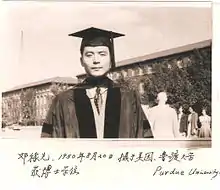China Academy of Engineering Physics (CAEP) (Chinese: 中国工程物理研究院, nicknamed 九院) was founded in October 1958. The CAEP is China's organization conducting the research, development, and testing of nuclear weapons and related science. Formerly called the Ninth Institute, CAEP was initially located in Beijing. Major components of its nuclear program were relocated to Qinghai Province in the 1950s. After China's first nuclear test in 1964, major components of the CAEP and China's nuclear weapons research, development, and production were moved to Sichuan Province to avoid detection by foreign powers.[1] The academy was formerly named the Ninth Academy (or Institute) of the Second Ministry of Machine Industry. It was renamed the China (or Chinese) Academy of Engineering Physics in the 1980s.[2][3][4] CAEP has been on the United States Department of Commerce's Entity List since 1997.[5]
Organization
The CAEP headquarters, since the 1980s, is in the 839 area of Mianyang and covers a land area of 5 km2. It's nicknamed Scientific Town. It has multiple components located in Beijing, Jiangyou, Mianyang, Chengdu, and Shanghai.[2]

As of 2017, the CAEP staff has included as many as 23,000 scientists, engineers, mathematicians, and technicians.[6]
Since the 1990s, the CAEP has included 12 research institutes and 15 national key laboratories. Its research areas include theoretical physics, plasma physics, engineering and material sciences, electronics and photo-electronics, materials chemistry and chemical engineering, computer science, and computational mathematics. Most of the names of the research organizations in the Mianyang area include "Southwest Institute" in their titles because they are located in the southwest part of China. The CAEP institutes include:[7][2][3][1][8]
- Graduate School, Beijing[7]
- Southwest Computer Center[1]
- Institute of Applied Physics and Computational Mathematics, Beijing[1][7]
- Southwest Institute of Chemical Materials, China[1][7][8]
- Southwest Institute of Environmental Testing[1]
- Southwest Institute of Electronic Engineering[1]
- Southwest Institute of Explosives and Chemical Engineering[1]
- Southwest Institute of Fluid Physics, China[1][7][8]
- Southwest Institute of Environmental Testing[1]
- Southwest Institute of Nuclear Physics and Chemistry, Mianyang 621900, Sichuan Province[1][7][8]
- Southwest Institute of Structural Mechanics, Mianyang 621900, Sichuan Province[1][7][8]
- Institute of Systems Engineering, Mianyang 6219000, Sichuan Province[7]
- Terahertz Research Center, Mianyang, Sichuan Province[7]
- Research Center of Laser Fusion, Mianyang, Sichuan Province[7]
Notable and Prominent Chinese scientists that have been leaders of the academy
- Yu Min (1926–2016), nuclear weapons designer
- Wang Ganchang (1907–1998), vice director of the Ninth Academy
- Deng Jiaxian (1924–1986), considered the father of China's nuclear weapons program
- Zhu Guangya (1924–2011), first director of the CAEP in 1994
- Chen Nengkuan (1923–2016), key contributor to the nuclear weapons program
- Zhou Guangzhao (1929– ), director of the nuclear weapons institute
- Guo Yonghuai (1909–1968), vice director of the Ninth Institute in 1960
- Cheng Kaijia (1918–2019), nuclear weapons designer and director of the Lop Nur test site
- Peng Huanwu (1915–2007), led the development of the first fission and thermonuclear weapons
The CAEP has included as many as 14 academicians of the Chinese Academy of Sciences (CAS) and 15 academicians of the Chinese Academy of Engineering (CAE), as well as many other outstanding Chinese scientists and engineers.[2]
See also
References
- 1 2 3 4 5 6 7 8 9 10 11 12 "Chinese Academy of Engineering Physics". NTI.org. Archived from the original on June 24, 2019. Retrieved June 24, 2019.
- 1 2 3 4 Lewis, John W. (August 1, 1988). China Builds the Bomb (Studies in Intl Security and Arm Control). ISBN 978-0804718417.
- 1 2 Goertz, Bill (February 5, 2013). The China Threat: How the People's Republic Targets America. Simon and Schuster. ISBN 978-1621571155.
- ↑ "中国工程物理研究院 (China Academy of Engineering Physics website". Archived from the original on 2017-11-25. Retrieved 2018-01-12.
- ↑ Lin, Liza; Strumpf, Dan (January 29, 2023). "China's Top Nuclear-Weapons Lab Used American Computer Chips Decades After Ban". The Wall Street Journal. Retrieved 2023-01-30.
- ↑ "Home". caep.cn.
- 1 2 3 4 5 6 7 8 9 10 selected publications
- 1 2 3 4 5 "Chinese Academy of Engineering Physics". FAS.org. Archived from the original on February 24, 2020. Retrieved June 24, 2019.